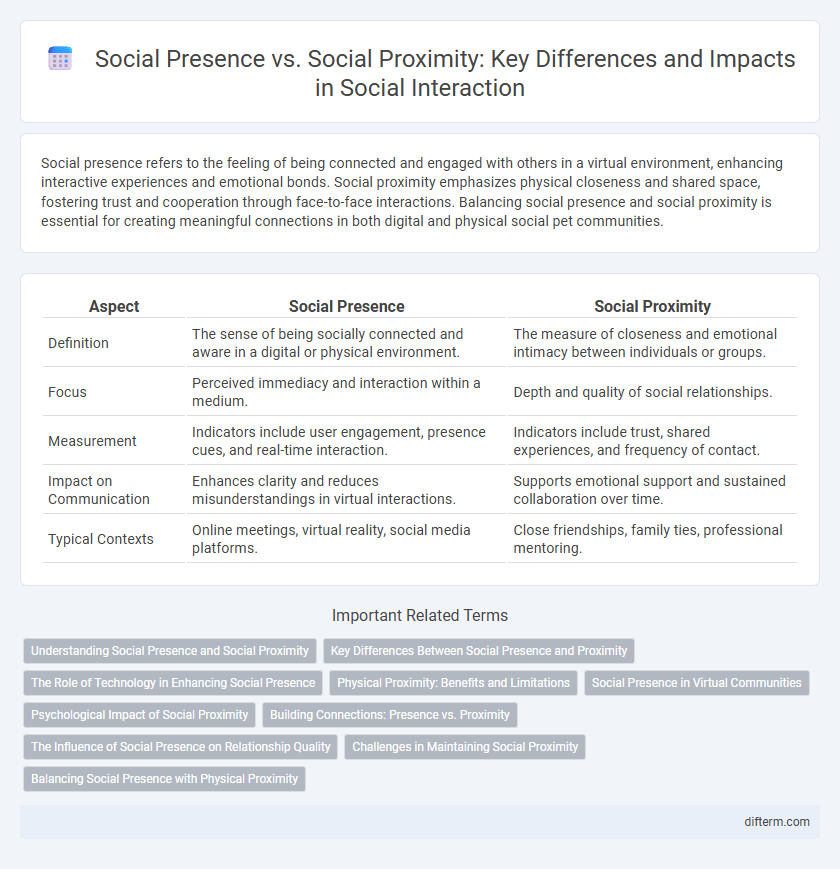Social presence refers to the feeling of being connected and engaged with others in a virtual environment, enhancing interactive experiences and emotional bonds. Social proximity emphasizes physical closeness and shared space, fostering trust and cooperation through face-to-face interactions. Balancing social presence and social proximity is essential for creating meaningful connections in both digital and physical social pet communities.
Table of Comparison
| Aspect | Social Presence | Social Proximity |
|---|---|---|
| Definition | The sense of being socially connected and aware in a digital or physical environment. | The measure of closeness and emotional intimacy between individuals or groups. |
| Focus | Perceived immediacy and interaction within a medium. | Depth and quality of social relationships. |
| Measurement | Indicators include user engagement, presence cues, and real-time interaction. | Indicators include trust, shared experiences, and frequency of contact. |
| Impact on Communication | Enhances clarity and reduces misunderstandings in virtual interactions. | Supports emotional support and sustained collaboration over time. |
| Typical Contexts | Online meetings, virtual reality, social media platforms. | Close friendships, family ties, professional mentoring. |
Understanding Social Presence and Social Proximity
Social presence refers to the feeling of being psychologically connected with others during communication, emphasizing the immediacy and awareness of interaction in digital or face-to-face environments. Social proximity, on the other hand, pertains to the perceived closeness and emotional bonds between individuals, influenced by shared experiences and mutual understanding. Understanding both concepts enhances the effectiveness of social interactions by balancing the immediacy of engagement with the depth of relational connection.
Key Differences Between Social Presence and Proximity
Social presence refers to the sense of being with others in a virtual environment, emphasizing emotional connection and interpersonal interaction, while social proximity focuses on the physical or spatial closeness between individuals, influencing communication frequency and immediate social feedback. Social presence enhances online collaboration and engagement through perceived interpersonal warmth, whereas social proximity facilitates face-to-face interactions and nonverbal cues. Understanding these key differences is crucial for designing effective social environments, whether digital platforms or physical spaces.
The Role of Technology in Enhancing Social Presence
Technology significantly enhances social presence by enabling real-time, immersive interactions through video calls, virtual reality, and augmented reality platforms. These tools bridge physical distances, creating a sense of closeness and immediacy that strengthens social proximity despite geographical separation. High-quality audio-visual communication and interactive features foster emotional connection, trust, and engagement among users.
Physical Proximity: Benefits and Limitations
Physical proximity enhances social presence by enabling nonverbal cues such as body language and eye contact, which strengthen interpersonal connections and trust. This closeness facilitates spontaneous interactions and collaborative activities, boosting empathy and mutual understanding among individuals. However, physical proximity can also impose limitations like reduced privacy and potential discomfort in crowded or confined spaces, impacting social dynamics.
Social Presence in Virtual Communities
Social presence in virtual communities refers to the degree to which individuals perceive others as real and emotionally connected during online interactions, enhancing engagement and trust. High social presence fosters stronger relationships by enabling users to convey emotions and social cues through avatars, text, and multimedia. Research shows that increased social presence improves collaboration, satisfaction, and loyalty among community members in diverse virtual environments.
Psychological Impact of Social Proximity
Social proximity, characterized by close physical and emotional connections, significantly enhances psychological well-being by fostering feelings of safety, trust, and belonging. Unlike social presence, which refers to the mere awareness of others, social proximity deeply influences stress reduction and emotional support systems. This close relational dynamic activates neurological pathways associated with reward and attachment, promoting mental health resilience.
Building Connections: Presence vs. Proximity
Building connections thrives on social presence, which emphasizes the quality of interaction and emotional engagement over mere physical closeness. Social proximity relies on geographic or spatial nearness, but meaningful relationships are often forged through consistent, authentic communication enabled by digital platforms. High social presence fosters trust and intimacy, making connections resilient regardless of distance.
The Influence of Social Presence on Relationship Quality
Social presence significantly enhances relationship quality by fostering trust, empathy, and emotional connection between individuals in digital communication. Higher levels of social presence create a sense of immediacy and personal involvement, which reduce misunderstandings and promote more meaningful interactions. This psychological closeness strengthens relational bonds, making social presence a critical factor in maintaining long-term social proximity and interpersonal satisfaction.
Challenges in Maintaining Social Proximity
Maintaining social proximity faces challenges such as physical distance, which limits spontaneous interactions and weakens emotional bonds despite digital communication tools. Time constraints and busy schedules reduce opportunities for meaningful face-to-face engagement, impacting shared experiences that reinforce closeness. Social and cultural differences may also create barriers to understanding and empathy, hindering the development of deep, proximate relationships.
Balancing Social Presence with Physical Proximity
Balancing social presence with physical proximity enhances communication effectiveness by ensuring interpersonal connections remain strong regardless of distance. Social presence technology, such as video conferencing and virtual collaboration tools, bridges gaps when physical proximity is limited, fostering engagement and trust. Optimizing this balance improves teamwork, reduces misunderstandings, and supports psychological well-being in both remote and hybrid social environments.
social presence vs social proximity Infographic

 difterm.com
difterm.com